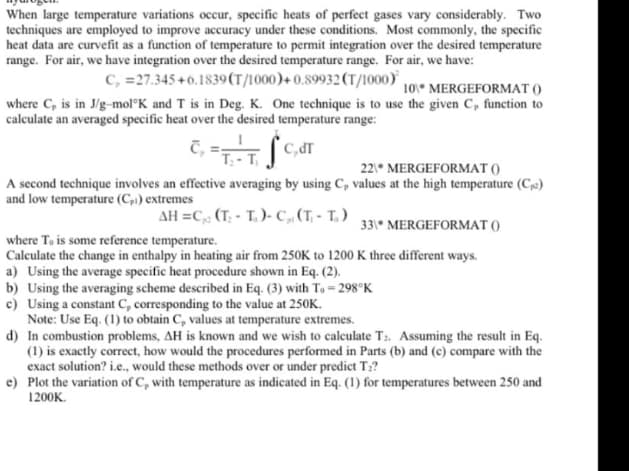change in enthalpy in heating air from 250K to 1200 K three different ways.
change in enthalpy in heating air from 250K to 1200 K three different ways.
Introduction to Chemical Engineering Thermodynamics
8th Edition
ISBN:9781259696527
Author:J.M. Smith Termodinamica en ingenieria quimica, Hendrick C Van Ness, Michael Abbott, Mark Swihart
Publisher:J.M. Smith Termodinamica en ingenieria quimica, Hendrick C Van Ness, Michael Abbott, Mark Swihart
Chapter1: Introduction
Section: Chapter Questions
Problem 1.1P
Related questions
Question
Urgent solution required

Transcribed Image Text:When large temperature variations occur, specific heats of perfect gases vary considerably. Two
techniques are employed to improve accuracy under these conditions. Most commonly, the specific
heat data are curvefit as a function of temperature to permit integration over the desired temperature
range. For air, we have integration over the desired temperature range. For air, we have:
C, =27.345+0.1839 (T/1000)+0.89932 (T/1000)
10 MERGEFORMAT())
where C, is in J/g-mol K and T is in Deg. K. One technique is to use the given C, function to
calculate an averaged specific heat over the desired temperature range:
fc, dr
T₂-
22\* MERGEFORMAT()
A second technique involves an effective averaging by using C, values at the high temperature (C₁2)
and low temperature (C₂1) extremes
AH =C₁ (T₂-T.)- C₁ (T. -T.)
33\* MERGEFORMAT()
where To is some reference temperature.
Calculate the change in enthalpy in heating air from 250K to 1200 K three different ways.
a) Using the average specific heat procedure shown in Eq. (2).
b) Using the averaging scheme described in Eq. (3) with To = 298 K
c) Using a constant C, corresponding to the value at 250K.
Note: Use Eq. (1) to obtain C, values at temperature extremes.
d) In combustion problems, AH is known and we wish to calculate T₂. Assuming the result in Eq.
(1) is exactly correct, how would the procedures performed in Parts (b) and (c) compare with the
exact solution? i.e., would these methods over or under predict T₂?
e) Plot the variation of C, with temperature as indicated in Eq. (1) for temperatures between 250 and
1200K.
Expert Solution
This question has been solved!
Explore an expertly crafted, step-by-step solution for a thorough understanding of key concepts.
Step by step
Solved in 3 steps with 3 images

Recommended textbooks for you

Introduction to Chemical Engineering Thermodynami…
Chemical Engineering
ISBN:
9781259696527
Author:
J.M. Smith Termodinamica en ingenieria quimica, Hendrick C Van Ness, Michael Abbott, Mark Swihart
Publisher:
McGraw-Hill Education

Elementary Principles of Chemical Processes, Bind…
Chemical Engineering
ISBN:
9781118431221
Author:
Richard M. Felder, Ronald W. Rousseau, Lisa G. Bullard
Publisher:
WILEY

Elements of Chemical Reaction Engineering (5th Ed…
Chemical Engineering
ISBN:
9780133887518
Author:
H. Scott Fogler
Publisher:
Prentice Hall

Introduction to Chemical Engineering Thermodynami…
Chemical Engineering
ISBN:
9781259696527
Author:
J.M. Smith Termodinamica en ingenieria quimica, Hendrick C Van Ness, Michael Abbott, Mark Swihart
Publisher:
McGraw-Hill Education

Elementary Principles of Chemical Processes, Bind…
Chemical Engineering
ISBN:
9781118431221
Author:
Richard M. Felder, Ronald W. Rousseau, Lisa G. Bullard
Publisher:
WILEY

Elements of Chemical Reaction Engineering (5th Ed…
Chemical Engineering
ISBN:
9780133887518
Author:
H. Scott Fogler
Publisher:
Prentice Hall


Industrial Plastics: Theory and Applications
Chemical Engineering
ISBN:
9781285061238
Author:
Lokensgard, Erik
Publisher:
Delmar Cengage Learning

Unit Operations of Chemical Engineering
Chemical Engineering
ISBN:
9780072848236
Author:
Warren McCabe, Julian C. Smith, Peter Harriott
Publisher:
McGraw-Hill Companies, The